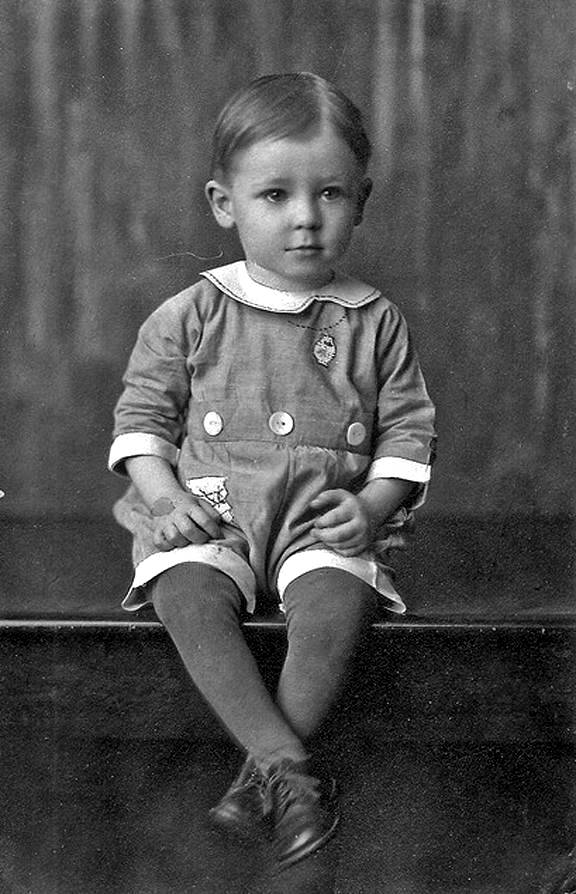
American Boys' Garments: Toddler Clothes

Figure 1.-This unidentified Kansas boy looks to be 2-3 years old. This portrait was taken in 1926. He is dressed in a button-on summer cotten suit trimmed in white on the trousers and sleeves, with a matching white Peter Pan collar. Botice the aplique and large white buttons. He wears dark brown cotton long stockings (obviously with a waist and supporters).
|
|
Toddler styles are a relatively modern creation. The moddern conception of the toddler is children from anout infancy to age 3 years or 1-3 years of age. Some boys at age 4 years might be dressed as todlers. A factor here is toilet training. Often toddler clothing had button snaps in the crotch area to facilitate diapper changes. There were no real toddler styles in the 19th century until the very late-19th century. Toddler age boys generally wore dresses like their sisters. Many boys wore dresses and other skirted garments beyond the toddler years. Here social class was a factor. Some boys wre breeched and began wearing older boys styles in their toddler years. This was more common in working-class than more affluent families. We note juvelie styles such as Little Lord Fauntleroy styles in the late-19th century. These were styles worn by toddlers and younger boys, especially pre-school boys although we see some school-age boys weaing them as well. The first dedicated toddler garments appear to be rompers. These were garments almost excusively worn by toddlers, in America both boys and girls. Tunics were also popular, but not exclusively worn by toddlers. We still see younger boys, including todlers, wearing dresses in the late-19th century. After the turn-of-the 20th century, dresses becanme less common for boys, but some toddlers still wore them. We begin to see more toddler outfits in the early-20th century, especially by the 1910s. In addition to rompers we see a variety of button-on outfits, although these styles such as Oliver Twist outfits ahd sailor suits were also worn by older boys. The buttons for toddler button-on outfits were often white and usually quite klarge. This was both a stylistic element as well as done to help the children who were just beginning gto learn to dress themselves. After World War I we begin to see a variety of play wear styles worn by todlers. Bright colors and plyful aplique were popular. Shortalls began to become popular in the 1930s as were bib-front shorts and longs. After Wotld War II, basic T-shirts and shorts in bright colors became very common for toddlers.
HBC

Navigate the Historic Boys' Clothing Web dress pages:
[Return to the Main U.S. garment page]
[Eton collars]
[Peter Pan collars]
[Floppy bows]
[Double-breasted styling]
[Hair styles]
Navigate the Boys' Historical Clothing Web Site:
[Introduction]
[Activities]
[Biographies]
[Chronology]
[Clothing styles]
[Countries]
[Bibliographies]
[Contributions]
[Essays]
[FAQs]
[Glossaries]
[Images]
[Links]
[Registration]
[Tools]
[Boys' Clothing Home]
Created: 8:11 PM 7/3/2011
Last updated: 8:11 PM 7/3/2011



